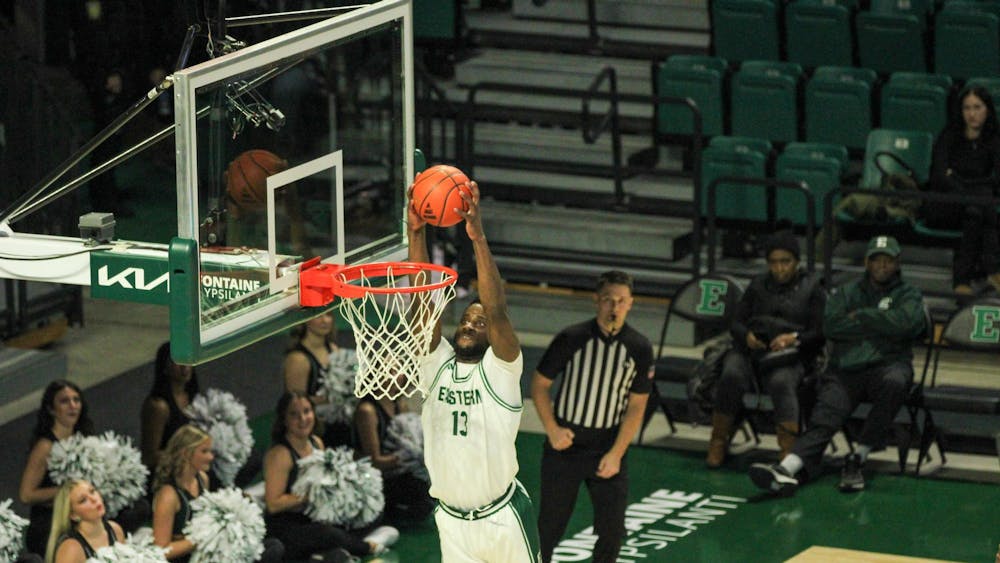At the southwest corner of Eastern Michigan University's campus is an oasis for student and staff research, curiosity and relaxation. It's the EMU greenhouse, housed in the Terrestrial and Aquatic Ecology Research Facility.
"The greenhouse brings a lot of life to the biology department and to campus," said Kinsey Ruffner, a greenhouse patron studying secondary education integrated science. " I really like that the greenhouse is available to all students, and you don’t need to be a specific major or person to enter."
Built in 1997, the greenhouse has three major rooms, each serving a different purpose.
In first room, plants are grown for sales, classes, research and more. It is called the Research Room.
The second, called the Propagation Room, houses the actual sales area, with various types of plants available at prices ranging from $1-$20. This room also houses the majority of non-sale plants that are part of the greenhouse coordinators collection.
The third room in the greenhouse is the Conservatory where the majority of the plants are housed in the greenhouse collection, and where students can come in to relax at a study table in the back.
Brad Cross is the greenhouse coordinator. An Eastern alumnus, Cross has worked in the greenhouse since 2016. Cross majored in biology and has a passion for plants. He said he found the greenhouse while working on his undergraduate degree and fell in love with the space. He said he couldn't wait to work there.
The 1,156-square-foot structure cost a half a million to build, adjacent to the Mark Jefferson Science Complex.
The new structure's first greenhouse coordinator was Judy Mcbride. She served in that role from 1997-2016. She also served as Cross' mentor.
"I asked Judy if I could work there — and came back every semester till I got the job,” Cross said.
Before the new building was finished in 1997, the greenhouse was housed in a wood shack behind the Hover Building, which is across a courtyard from the science complex. The Hover greenhouse featured a place for plant specimens, and was connected to the back of the Hover, which housed biology laboratories.
The greenhouse's original purpose was designed for student experiments in a cookie-cutter format that, in recent years, has been shifting to a project-based format. Students come up with their own experiments to self-engage and actively think about research.
About 50 students have research projects in the greenhouse, with the majority of the research being for the introduction to biology course (BIO 121). Biology professor Emily Grman, who earned a doctorate at Michigan State University and teaches a range of courses, has for years maintained germinated prairie species in the greenhouse. Other professors also keep plants and conduct research in the greenhouse.
The conservatory was originally designed as a plant library for professors to borrow plants for use in the lab and lecture classes. While that still happens, the classes have shifted into doing more greenhouse tours.
“The density and variety of stuff that is here is really awesome. Some of the tables literally do not have any space to fit another pot,” greenhouse assistance Dan Ruffling said. “There is a huge variety, everything from nonvascular little mosses all the way up to really huge trees.”
Cross said that among his objectives when taking over the greenhouse were getting rid of the pests and focusing on the structure of the plants in the greenhouse.
“I threw the kitchen sink at them [the pests] until I got them under control, and the plants are now feeling that relief,” Cross said.
He said he wants to improve the current layout of the greenhouse to make everything more accessible. The focus is to get more epiphytes, which are plants that grown on other plants without harming the host, growing on the larger trees. He'd also like to see more canopy trees overall, to give shade to smaller plants and create an overall cover in the greenhouse.
“I was exposed to tropical plants and the humid environment at a young age,” Cross said. “I wanted to create a tropical feel in the conservatory.”
The greenhouse opened the door to The Botanical Society of America at EMU, which started in 2018 and runs out of the greenhouse. The club has about 30 active members and a leadership board of five.
Anyone can visit the EMU greenhouse during its regular operating hours, 8:30 a.m. to 2:30 p.m. Monday through Thursday. Those interested in visiting can also make an appointment with Cross, by emailing him at bcross@emich.edu.
“I enjoy every moment here,” Cross said. “I like nerding out with students about plants and picking up their positivity about plants and them getting excited and sharing stuff with me. I learn something new every day.”









